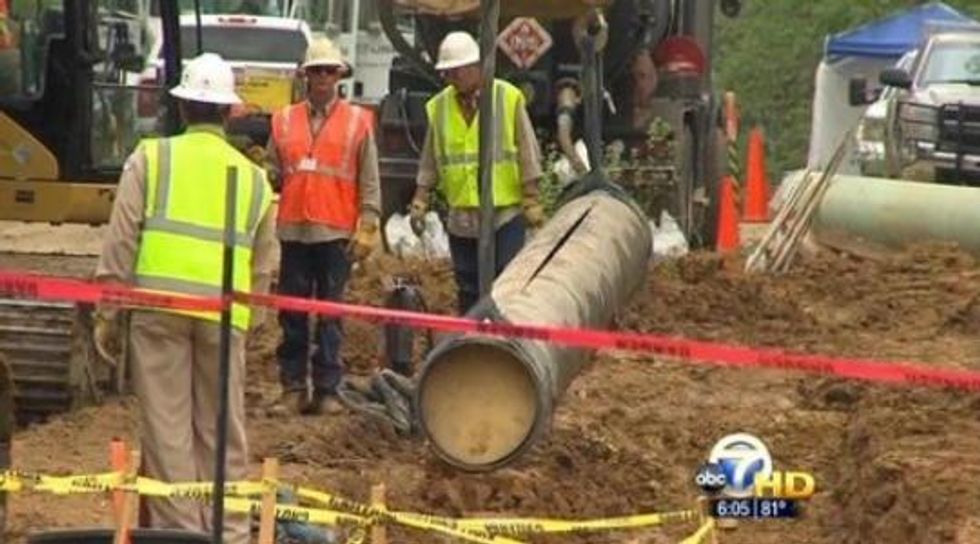

SUBSCRIBE TO OUR FREE NEWSLETTER
Daily news & progressive opinion—funded by the people, not the corporations—delivered straight to your inbox.
5
#000000
#FFFFFF
To donate by check, phone, or other method, see our More Ways to Give page.


Daily news & progressive opinion—funded by the people, not the corporations—delivered straight to your inbox.

An examination of the 70-year-old Pegasus pipeline and its 22-foot-gash found that the pipeline failure "resulted from an original manufacturing defect of the electronic resistance welded (ERW) pipe," according to a spokesman from the Hurst Metallurgical Research Laboratory.
Citing an ongoing investigation, both Exxon and the Pipeline and Hazardous Materials Safety Administration (PHMSA) waited nearly a month after receiving the report before releasing the details to Arkansas newspaper Log Cabin Democrat Thursday.
Implications of the report are significant as it shows that pipelines "similarly manufactured, and in the same era as the ruptured line in Mayflower, are inferior and susceptible to failure," the Democrat reports.
A pipeline industry insider who declined to be named told Common Dreams that there are "tens of thousands of miles of pipeline in the ground and operating from the approximate vintage" as the Pegasus pipeline.
"The fact of the matter is, any pre-1970s pipeline was manufactured with old technologies," John Tynan, Watershed Protection Manager with Central Arkansas Water, told Common Dreams.
"The only way to eliminate their risk is to completely remove the pipelines and shut down the operation," he added.
A 1989 assessment of ERW pipelines conducted by the National Institute of Standards and Technology under the U.S. Department of Commerce found that pipelines manufactured in the 1940s using the ERW technique are "inherently susceptible to seam failures."
Further, the Democrat reports:
Trade publication "Oil and Gas Journal" author Dr. John F. Kiefner, founder of Kiefner and Associates pipeline consulting firm, of which Exxon is a client, points to pressure management as a solution for the widely "problematic ERW pipe." [...]
Kiefner wrote in a 1992 report published in the journal that raising the pressure level in a defective segment of pipe can lead to failure, and flaws in ERW pipelines may grow while the pipe is in service, due to large pressure fluctuations.
PHMSA records show Exxon reversed the pipeline's flow in 2006 when product volume increased and the pipe began carrying the heavy crude, also called diluted bitumen, from Illinois to Texas.
"A change in the direction of flow can affect the hydraulic and stress demands on the pipeline," PHMSA's corrective order issued to Exxon after the March 29 spill states.
_____________________
Dear Common Dreams reader, The U.S. is on a fast track to authoritarianism like nothing I've ever seen. Meanwhile, corporate news outlets are utterly capitulating to Trump, twisting their coverage to avoid drawing his ire while lining up to stuff cash in his pockets. That's why I believe that Common Dreams is doing the best and most consequential reporting that we've ever done. Our small but mighty team is a progressive reporting powerhouse, covering the news every day that the corporate media never will. Our mission has always been simple: To inform. To inspire. And to ignite change for the common good. Now here's the key piece that I want all our readers to understand: None of this would be possible without your financial support. That's not just some fundraising cliche. It's the absolute and literal truth. We don't accept corporate advertising and never will. We don't have a paywall because we don't think people should be blocked from critical news based on their ability to pay. Everything we do is funded by the donations of readers like you. Will you donate now to help power the nonprofit, independent reporting of Common Dreams? Thank you for being a vital member of our community. Together, we can keep independent journalism alive when it’s needed most. - Craig Brown, Co-founder |

An examination of the 70-year-old Pegasus pipeline and its 22-foot-gash found that the pipeline failure "resulted from an original manufacturing defect of the electronic resistance welded (ERW) pipe," according to a spokesman from the Hurst Metallurgical Research Laboratory.
Citing an ongoing investigation, both Exxon and the Pipeline and Hazardous Materials Safety Administration (PHMSA) waited nearly a month after receiving the report before releasing the details to Arkansas newspaper Log Cabin Democrat Thursday.
Implications of the report are significant as it shows that pipelines "similarly manufactured, and in the same era as the ruptured line in Mayflower, are inferior and susceptible to failure," the Democrat reports.
A pipeline industry insider who declined to be named told Common Dreams that there are "tens of thousands of miles of pipeline in the ground and operating from the approximate vintage" as the Pegasus pipeline.
"The fact of the matter is, any pre-1970s pipeline was manufactured with old technologies," John Tynan, Watershed Protection Manager with Central Arkansas Water, told Common Dreams.
"The only way to eliminate their risk is to completely remove the pipelines and shut down the operation," he added.
A 1989 assessment of ERW pipelines conducted by the National Institute of Standards and Technology under the U.S. Department of Commerce found that pipelines manufactured in the 1940s using the ERW technique are "inherently susceptible to seam failures."
Further, the Democrat reports:
Trade publication "Oil and Gas Journal" author Dr. John F. Kiefner, founder of Kiefner and Associates pipeline consulting firm, of which Exxon is a client, points to pressure management as a solution for the widely "problematic ERW pipe." [...]
Kiefner wrote in a 1992 report published in the journal that raising the pressure level in a defective segment of pipe can lead to failure, and flaws in ERW pipelines may grow while the pipe is in service, due to large pressure fluctuations.
PHMSA records show Exxon reversed the pipeline's flow in 2006 when product volume increased and the pipe began carrying the heavy crude, also called diluted bitumen, from Illinois to Texas.
"A change in the direction of flow can affect the hydraulic and stress demands on the pipeline," PHMSA's corrective order issued to Exxon after the March 29 spill states.
_____________________

An examination of the 70-year-old Pegasus pipeline and its 22-foot-gash found that the pipeline failure "resulted from an original manufacturing defect of the electronic resistance welded (ERW) pipe," according to a spokesman from the Hurst Metallurgical Research Laboratory.
Citing an ongoing investigation, both Exxon and the Pipeline and Hazardous Materials Safety Administration (PHMSA) waited nearly a month after receiving the report before releasing the details to Arkansas newspaper Log Cabin Democrat Thursday.
Implications of the report are significant as it shows that pipelines "similarly manufactured, and in the same era as the ruptured line in Mayflower, are inferior and susceptible to failure," the Democrat reports.
A pipeline industry insider who declined to be named told Common Dreams that there are "tens of thousands of miles of pipeline in the ground and operating from the approximate vintage" as the Pegasus pipeline.
"The fact of the matter is, any pre-1970s pipeline was manufactured with old technologies," John Tynan, Watershed Protection Manager with Central Arkansas Water, told Common Dreams.
"The only way to eliminate their risk is to completely remove the pipelines and shut down the operation," he added.
A 1989 assessment of ERW pipelines conducted by the National Institute of Standards and Technology under the U.S. Department of Commerce found that pipelines manufactured in the 1940s using the ERW technique are "inherently susceptible to seam failures."
Further, the Democrat reports:
Trade publication "Oil and Gas Journal" author Dr. John F. Kiefner, founder of Kiefner and Associates pipeline consulting firm, of which Exxon is a client, points to pressure management as a solution for the widely "problematic ERW pipe." [...]
Kiefner wrote in a 1992 report published in the journal that raising the pressure level in a defective segment of pipe can lead to failure, and flaws in ERW pipelines may grow while the pipe is in service, due to large pressure fluctuations.
PHMSA records show Exxon reversed the pipeline's flow in 2006 when product volume increased and the pipe began carrying the heavy crude, also called diluted bitumen, from Illinois to Texas.
"A change in the direction of flow can affect the hydraulic and stress demands on the pipeline," PHMSA's corrective order issued to Exxon after the March 29 spill states.
_____________________